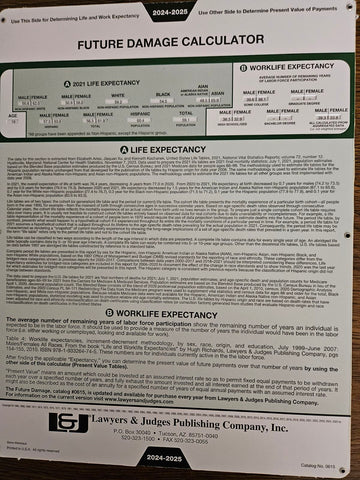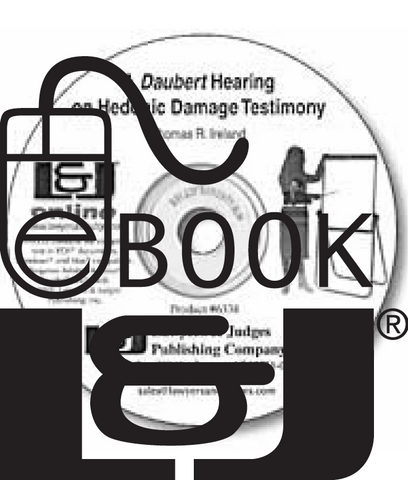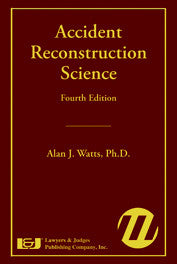
Workplace Injury Litigation
- Authors: Todd McFarren & Glen J Grossman
- ISBN 10: 1-930056-12-5
- ISBN 13: 978-1-930056-12-1
- Copyright Date Ed: January 1, 2004
- Pages: 510
- Binding Information: Casebound
- Size: 6 ✕ 9 Inches (US)
This text is designed to serve as an important resource for legal professionals involved in workplace injury law. It explores the most common types of injuries that occur in the workplace, guides you through the practice and procedure of workplace compensation law, and delves into the ethics and administration of the systems currently in place.
The compensability of on-the-job injuries and death varies from state to state, many genuine injuries are subjective (i.e., with little or no physical evidence of damage), insurance companies can and do vigorously resist the payment of benefits, the bureaucracy of the appeals process can be a tangle . . .
This volume provides ideas, analysis, techniques and appraisals of various workers' compensation issues for practitioners by practitioners. Editors McFarren and Grossman have gathered chapters from leading medical and legal experts in the field. Attorneys and judges--as well as healthcare providers, employers, insurance company representatives and vocational experts--will find new ideas, fresh perspectives and just plain good advice.
This book is also available as an eBook. Click here to purchase and download:
Topics covered include
- wrongful termination in workers' compensation
- deposing your opponent's medical experts
- ethical considerations for workers' compensation practitioners
- the bankrupt uninsured employer
- compensability of work-related heart attacks
- subjective disability
- the psychiatric injury
- occupational skin disorders
- when is an employee not covered
- spine injuries in the workplace
- concurrency and conflictcross-examinging the vocational expert
- taking the doctor's deposition: advice for attorneys and doctors.
Table of Contents:
Part 1. Types of Injuries
1. Compensability of Work-Related Heart Attacks
1.1 Introduction
1.2 Cardiotoxic Chemicals
1.3 Hazardous Work
1.4 The Range of Legal Rules
1.5 Heart Attacks Resulting from Physical Exertion at the Workplace
2. Occupational Injuries to the Hands and Arms
2.1 Introduction
2.2 Skeletal Structure of the Hand and Arm
2.3 Nerves of the Hand and Arm
2.4 Sensory Branches of the Nerves
2.5 Muscle and Tendon Injuries
2.6 Ligaments and Bursa
2.7 Common Tendon Injuries
2.8 Hand-Arm Vibration Syndrome
2.9 Carpal Tunnel Syndrome
2.10 Ergonomic Factors Affecting the Hand
2.11 Hand-Wrist Tendonitis
2.12 Occupational Dermatitis
3.The Psychiatric Injury
3.1 Introduction
3.2 The Interview
3.3 Developing Evidence
3.4 Obtaining Documents
3.5 Foreign Language Problems
3.6 Protecting the Injured Worker
3.7 Identifying and Measuring Disability
3.8 Conclusion
4. Analyzing a Spinal Injury Case
4.1 Introduction
4.2 Anatomy and Medical Terminology
4.3 Diagnostic Tests
4.4 Workers’ Compensation Benefits for Workers with Spine Injuries
4.5 Case Study
4.6 Conclusion
5. How to Analyze and Try the Knee-Injury Case
5.1 Introduction
5.2 Anatomy of the Knee
5.3 Common Knee Injuries and Diseases
5.4 The Knee-Injury Claim and the Law
5.5 Conclusion
6. Managing Chronic Pain: Getting the Dysfunctional Injured Worker Back to Work
6.1 Introduction
6.2 The Players and the Playing Field
6.3 From Initial Injury to Chronic Pain
6.4 Treatment and Rehabilitation for Acute Injuries
6.5 Summary
7. Subjective Disability
7.1 Introduction
7.2 What is Subjective Disability?
7.3 Assessing Subjective Disability
7.4 Self-Reporting of Pain
7.5 The Doctor’s Assessment of Subjective Disability
7.6 The Good Doctor: An Ideal Type
7.7 Presenting the Case
7.8 Conclusion
8. Occupational Skin Disorders
8.1 Introduction
8.2 Causation Issues
8.3 Examples
8.4 Conclusion
Part 2. Practice and Procedure
9. Cross-Examining the Vocational Expert
9.1 Introduction
9.2 Initial Preparation
9.3 Credentials
9.4 Formal Training and Experience
9.5 Bias
9.6 Tools of the Trade
9.7 Foundation for Opinion
9.8 Validation of Client’s Credibility
9.9 Evolution of Theme
9.10 Foundation—Familiarity with Employment Region
9.11 Job versus Occupational Classification
9.12 Expose Conflicts between Opinion and Tools of the Trade
9.13 Extrapolation from the Sublime to the Ridiculous
9.14 Computerized Programs
9.15 More Chinks in the Foundation
9.16 Questionable Methods
9.17 Are Those Jobs Smoke and Mirrors
9.18 Incomplete or Faulty Analysis
9.19 Independent Vocational Rehabilitation Vendors
9.20 Conclusion
10. Deposing Your Opponent’s Medical Expert
10.1 Introduction
10.2 Informational Depositions
10.3 Depositions to Enhance the Case or Attack the Opponent’s Case
10.4 Conclusion
11. Taking the Doctor’s Deposition: Advice for Attorneys and Doctors
11.1 Introduction
11.2 Advice for Attorneys
11.3 Advice for Physicians
11.4 Conclusion
12. The Bankrupt Uninsured Employer—Clarifying the Distinction between the Automatic Stay and the Statutory Discharge
12.1 Introduction
12.2 The Mysterious World of the Bankruptcy Court
12.3 Conclusion
13. Special Benefits for California Public Safety Employees
13.1 Introduction
13.2 Presumptions of Injury
13.3 Full Salary Benefits while Temporarily Totally Disabled
13.4 Public Safety Employee Disability Retirement
13.5 Judicial Review
14. Concurrency and Conflict
14.1 Introduction
14.2 Part I: Selected Statutes and Benefits
14.3 Part II: Longshore Interface with State Workers’ Compensation and Concurrency
14.4 Part III: Conflict of Laws in Workers’ Compensation
15. When Is an Employee Not Covered? When Is a Carrier Estopped to Deny Coverage? A Case Study
15.1 Introduction
15.2 Mr. Applicant Was an Insured Residential Employee
15.3 Estoppel
15.4 Scott Was Not Applicable
15.5 Conclusion
16. Wrongful Termination in Workers’ Compensation
16.1 Introduction
16.2 Elements of the Retaliatory Discharge Claim
16.3 Establishing the Employer’s Retaliatory Motive
16.4 Addressing Specific Defenses to the Retaliatory Discharge Action
16.5 Miscellaneous Issues
17. Representing Undocumented Workers
17.1 Introduction
17.2 Coverage for Undocumented Workers in a Few Jurisdictions
17.3 Typical Arguments against Coverage for Undocumented Workers
17.4 Questions Often Asked at Deposition
17.5 Conclusion
Part 3. Ethical and Administrative Issues
18. Ethical Considerations for Workers’ Compensation Practitioners
18.1 Preface
18.2 Hypotheticals
18.3 Rule 1.1—Competence
18.4 Rule 1.3—Diligence
18.5 Rule 1.4—Communication
18.6 Rule 1.5—Fees
18.7 Rule 1.6—Confidentiality of Information
18.8 Rule 1.7—Conflict of Interest: General Rule
18.9 Rule 1.8—Conflict of Interest: Prohibited Transactions
18.10 Rule 1.9—Conflict of Interest: Former Client
18.11 Rule 1.10—Imputed Disqualification General Rule
18.12 Rule 1.14—Client under a Disability
18.13 Rule 1.16—Declining or Terminating Representation
18.14 Rule 2.1—Advisor
18.15 Rule 2.2—Intermediary
18.16 Rule 3.1—Meritorious Claims and Contentions
18.17 Rule 3.2—Expediting Litigation
18.18 Rule 3.3—Candor toward the Tribunal
18.19 Rule 3.4—Fairness to Opposing Party and Counsel
18.20 Rule 3.5—Impartiality and Decorum of the Tribunal
18.21 Rule 3.6—Trial Publicity
18.22 Rule 3.7—Lawyer as Witness
18.23 Rule 3.9—Advocate in Nonadjudicative Proceedings
18.24 Rule 4.1—Truthfulness in Statements to Others
18.25 Rule 4.2—Communication with Person Represented by Counsel
18.26 Rule 4.3—Dealing with Unrepresented Person
18.27 Rule 4.4—Respect for Rights of Third Persons
18.28 Rule 5.1—Responsibilities of a Partner or Supervisory Lawyer
18.29 Rule 5.2—Responsibilities of a Subordinate Lawyer
18.30 Rule 5.3—Responsibilities Regarding Nonlawyer Assistants
18.31 Rule 5.4—Professional Independence of a Lawyer
18.32 Rule 5.5—Unauthorized Practice of Law
18.33 Rule 6.1—Voluntary Pro Bono Publico Service
18.34 Rule 7.1—Communications Concerning a Lawyer’s Services
18.35 Rule 7.2—Advertising
18.36 Rule 7.3—Direct Contact with Prospective Clients
18.37 Rule 7.4—Communication of Fields of Practice
18.38 Rule 8.3—Reporting Professional Misconduct
18.39 Rule 8.4—Misconduct
Appendix A. Preamble to the Model Rules of Professional Conduct
Appendix B. Common Representation Agreement
19. Exploring Legislative and Administrative Efforts to Reduce Litigation in the California Workers’ Compensation System
19.1 Introduction
19.2 The Early Years
19.3 Early Causes of Litigation in Workers’ Compensation
19.4 Remedies for Reducing Litigation
19.5 Did Any of These Remedies Achieve the Policy Goals of Reducing Litigation?
19.6 The Experience of Construction "Carve-Outs" in Reducing Litigation
19.7 From Statutes to Rules
19.8 Current Efforts to Reduce Litigation




